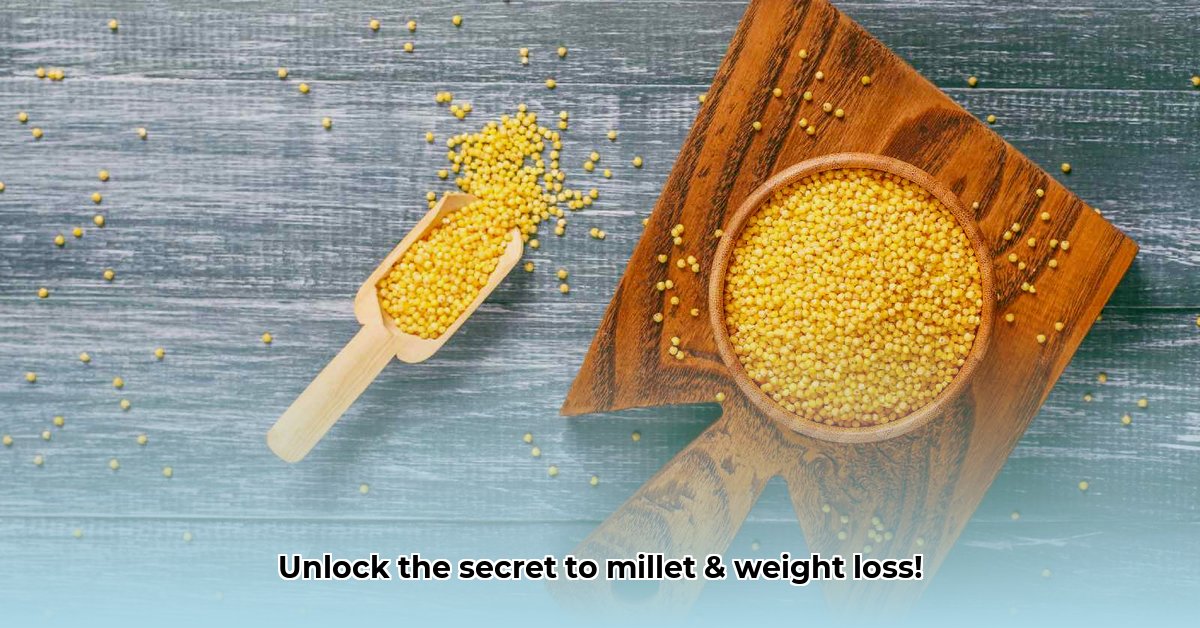
Which Millet Is Good for Weight Loss?
Tired of restrictive diets? Millets offer a delicious and effective pathway to weight loss. This guide explores different millet varieties, their nutritional profiles, and how to incorporate them into a balanced weight-management plan.
Understanding Millets: Tiny Grains, Big Benefits
Millets are nutrient-rich, small-seeded grains offering significant advantages for weight loss. Their high fiber content promotes satiety (feeling full), while their low glycemic index (GI) prevents blood sugar spikes and cravings. Additionally, their protein content supports muscle mass during weight loss. Let's delve into the specific benefits of different millet types.
Types of Millets: A Nutritional Comparison
Different millets possess unique nutritional profiles. The table below provides a comparison of popular varieties:
| Millet Type | Fiber (grams per 100 grams) | Protein (grams per 100 grams) | Glycemic Index (approximate) | Notable Characteristics |
|---|---|---|---|---|
| Foxtail Millet | 6-8 | 10-12 | Low (below 55) | Nutty flavor, cooks quickly |
| Pearl Millet | 5-7 | 9-11 | Low (below 55) | Hearty texture |
| Proso Millet | 4-6 | 10-12 | Low (below 55) | Resembles couscous |
| Little Millet | 8-10 | 11-13 | Low (below 55) | Slightly sweet flavor |
Note: Nutritional values are estimates and can vary.
Choosing the right millet depends on individual preferences and dietary needs. Experiment to discover your favorites!
How Millets Contribute to Weight Loss
Millets' weight-loss benefits stem from their nutritional composition:
- High Fiber: Promotes satiety, reducing overeating.
- Low Glycemic Index: Prevents blood sugar spikes and cravings.
- Protein Content: Supports muscle mass maintenance.
These combined effects contribute to a sustainable and healthy weight-loss journey. Is it surprising that millets help with weight loss given their impressive nutritional profile?
Incorporating Millets into Your Weight-Loss Plan: A Step-by-Step Guide
Integrating millets into your diet is straightforward:
Gradual Substitution: Begin by gradually replacing some of your usual grains (like rice or pasta) with millets.
Culinary Creativity: Millets are versatile. Experiment with them in porridge, salads, pilafs, or as a flour substitute in baking.
Enhancing Nutrient Absorption: Soaking or sprouting millets reduces phytic acid, improving mineral absorption. This process enhances the overall nutritional benefits.
Holistic Approach: Combine millets with lean proteins (chicken, fish, beans), vegetables, and healthy fats (avocado, nuts) for a balanced diet.
Choosing Your Perfect Millet: Taste and Texture Preferences
The ideal millet depends on your preferences:
- Nutty Flavor: Foxtail millet
- Hearty Texture: Pearl millet
- Couscous-like: Proso millet
- Subtle Sweetness: Little millet
Experimentation is key to finding your preferred millet variety.
Addressing Antinutrients: Optimizing Nutrient Absorption
Millets, like many grains, contain phytic acid, an antinutrient that can hinder mineral absorption. However, soaking, sprouting, or fermenting significantly reduces phytic acid levels, maximizing the nutritional benefits.
Conclusion: A Sustainable Weight Management Approach
Millets are a valuable tool for weight management, but they’re most effective as part of a balanced lifestyle. Remember portion control and combine millets with other nutritious foods for optimal results. Enjoy the process of discovering your perfect millet and building a healthier you!
How to Reduce Phytic Acid in Millets for Weight Loss
Key Takeaways:
- Millets offer significant weight loss benefits due to their high fiber, low GI, and protein content.
- Phytic acid, an antinutrient, can reduce mineral absorption. Strategies to minimize its impact are crucial.
- Soaking, sprouting, and fermentation effectively reduce phytic acid.
- Minor millets generally have lower GIs than major millets.
- Gradual millet integration and portion control are essential for effective weight management.
Choosing Your Millet Wisely: Major vs. Minor Millets
Major millets (like ragi) sometimes have higher GIs compared to minor millets (foxtail, kodo, barnyard). Minor millets often provide greater weight-loss benefits due to their lower GI and higher fiber. Consider these differences when making your selection. Do you prioritize rapid cooking times or a lower glycemic index?
Simple Strategies to Minimize Phytic Acid
Soaking (6-8 hours or overnight): Submerge millets in water to break down phytic acid.
Sprouting: Allow soaked millets to sprout, further reducing phytic acid and enhancing digestibility.
Fermentation: Fermentation, while more involved, offers an additional phytic acid reduction and adds probiotics.
Integrating Millets into Your Weight Loss Plan: A Balanced Approach
Remember that millet is part of a broader strategy. Balance your diet with lean proteins, vegetables, and healthy fats. Gradual integration is crucial, allowing your body to adapt.